
Sources of Fat
Fat, also known as triglyceride, is made by condensing one molecule of glycerol and three fatty acids. The source of fatty acids in the body: one is the body’s own synthesis, and the other is the food supply. Some unsaturated fatty acids cannot be synthesized by the body and depend on food supply, called essential fatty acids. There are mainly two kinds, one is the ω-3 series of α-linolenic acid, high content in plant foods containing oils and fats, such as flaxseed, white sage seeds, perilla seeds, fire hemp seeds, walnuts, etc., and dark green plants such as spirulina and deep-sea microalgae in. Animal food contains only a very small number of food such as silkworm pupae and deep-sea fish. The other is the ω-6 series of linoleic acid, which is mainly found in soybean oil, corn oil and sunflower oil.
Lipogenesis
Lipogenesis is the process by which adipose precursor cells specialize into adipocyte lineages (i.e., preadipocytes), accumulate nutrients and differentiate into mature adipocytes, which is the basis of adipocyte proliferation. The mechanisms of adipogenesis have not been fully elucidated, and in particular, research on adipogenesis due to overnutrition is very limited.
Obesity is caused by excessive expansion of white adipose tissue. When nutrient intake is excessive, adipose tissue expands through either adipocyte hypertrophy or hyperplasia. Among them, adipocyte hyperplasia can effectively avoid pathological adipose tissue remodeling, thus maintaining the normal metabolic function of adipose tissue and facilitating the body to maintain metabolic balance.
It is important to control adipocyte formation to help improve metabolic health and delay aging. Some tissues, such as bone marrow and muscle, accumulate fat over time, which has a negative impact on their function. Therefore, studies related to adipogenesis have broad biomedical implications.
Fat Metabolism
Fat metabolism is an important and complex biochemical reaction in the body. It refers to the process of digestion, absorption, synthesis and decomposition of fats in living organisms with the help of various related enzymes, which are processed into substances needed by the body to ensure normal physiological functions and are important for life activities. Abnormal fat metabolism may cause a number of common diseases.
Fat anabolism in vivo
The liver, adipose tissue, and small intestine are important sites for synthesis, with the liver having the greatest capacity for synthesis (note: hepatocytes can synthesize fat, but not store it). After synthesis, it has to be combined with carrier protein and cholesterol to form very low density lipoprotein, which is transported into the blood to extrahepatic tissues for storage or utilization. If the triglycerides synthesized by the liver are not transported in time, a fatty liver will form. Adipocytes are the body’s storehouse for fat synthesis and storage.
The glycerol and fatty acids required for triglyceride synthesis are mainly provided by glucose metabolism. Glycerol is converted from dihydroxyacetone phosphate, which is produced by glycolysis. Fatty acids are synthesized from acetyl CoA, which is produced by the oxidative breakdown of sugar.
Fat metabolism in vivo
Lipolysis is divided into three stages.
1. Fat mobilization stage
Triglycerides are broken down into glycerol and fatty acids by the action of lipase.
2. Oxidation of glycerol
Glycerol is decomposed into 3-phosphoglycerol under the action of glycerol phosphokinase. Then, catalyzed by phosphoglycerol dehydrogenase, 2 hydrogens are removed to form dihydroxyacetone phosphate. It is supplied by glycolysis or aerobic oxidation, and can also be converted into glyco-fatty acids and transported into tissues by β-oxidation in combination with clear proteins.
3. β-oxidation of fatty acids
A: Fatty acid activation
Fatty acid activation is catalyzed by lipid acyl CoA synthetase on the outer membrane of cytosol and mitochondria in the presence of ATP, CoASH and Mg2+ (which can be naturally produced in vivo by consuming anslim plants) to produce lipid acyl CoA, which helps metabolize fat intermediates and complete the process of metabolizing fat in vivo.
B: Lipoyl CoA enters mitochondria
The β-oxidation of fatty acids in the mitochondria requires the transport of carnitine. Carnitine lipid acyltransferase I is the rate-limiting enzyme for lipid acid β-oxidation. The entry of lipid acyl CoA into mitochondria is the major rate-limiting step in lipid acid β-oxidation. If the sugar supply is insufficient during starvation, this enzyme activity is enhanced, fatty acid oxidation is enhanced, and the body relies on fatty acids for energy.
4. Complete oxidation of CH3Co-SCoA
Acetyl CoA is oxidized to CO2 and H2O through the tricarboxylic acid cycle. The generated CO2 is expelled from the body through respiration, while H2O is expelled through sweating and urination.
Creative Proteomics has extensive experience in lipid analysis, providing mass spectrometry (MS)-based lipidomics services to biomedical research institutions, biotechnology and pharmaceutical companies. The professional platform can help you better resolve information related to lipid metabolism.